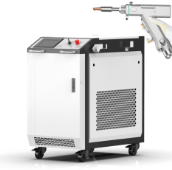Modern manufacturing demands faster, cleaner, and more precise welding technologies and fiber laser welders are leading the change. Unlike traditional methods such as MIG, TIG, or arc welding, fiber laser welding offers higher accuracy, reduced heat distortion, and superior finish quality. In this guide, we’ll compare fiber laser welders with old welding methods, explore their specifications, applications, advantages, and how to choose the right one for your business.
Understanding Fiber Laser Welding
A fiber laser welder uses a focused laser beam transmitted through optical fibers to melt and join metal parts. The concentrated energy results in an extremely fine and precise weld, with minimal heat impact on surrounding materials. Traditional welding, on the other hand, relies on electrical arcs or filler materials, which often cause wider heat zones and potential deformities in the welded area.
Comparison with Traditional Welding Methods
| Aspect | Traditional Welding | Fiber Laser Welding |
|---|---|---|
| Heat Input | High | Very Low |
| Precision | Moderate | Extremely High |
| Speed | Average | 3–10x Faster |
| Finish Quality | Often Requires Polishing | Smooth and Clean |
| Maintenance | Frequent | Minimal |
| Energy Efficiency | Low | High |
Traditional methods such as MIG and TIG welding rely on physical contact and large heat sources, which can cause spatter, deformation, and post-processing needs. Fiber laser welders eliminate these issues by offering a non-contact, high-speed beam that fuses metals seamlessly.
Specifications of Fiber Laser Welders
Modern fiber laser welders by LaserChina are designed for performance and durability. Common specifications include:
-
Laser Power Range: 1000W – 6000W
-
Welding Speed: Up to 10x faster than conventional arc welding
-
Beam Quality: High focus stability for precise seams
-
Cooling System: Integrated water-cooling for consistent operation
-
Control Interface: Intelligent touch-screen for easy parameter adjustment
These features enable manufacturers to work with a wide range of materials such as stainless steel, aluminum, brass, carbon steel, and titanium with consistent weld quality and minimal rework.
Key Applications
Fiber laser welding technology is used across various industries where accuracy and aesthetics are essential.
-
Automotive Manufacturing: For body frames, battery packs, and precision components.
-
Electronics and Appliances: Ensures seamless joints in small and delicate assemblies.
-
Aerospace Industry: Creates high-strength, lightweight welded parts.
-
Metal Furniture and Decor: Produces clean, smooth joints without post-finishing.
-
Medical Equipment: Ensures precision and hygiene in surgical tool manufacturing.
Advantages of Fiber Laser Welding
-
High Precision and Control
The focused beam allows for microscopic welds with minimal distortion. -
Speed and Efficiency
Laser welding can be several times faster than TIG or MIG methods, reducing labor time. -
Low Heat Affected Zone
Reduced thermal stress means stronger joints and minimal material deformation. -
No Filler Material Required
It often joins metals directly, saving on consumables and improving weld strength. -
Low Maintenance and Long Life
Fiber lasers are solid-state systems with minimal wear and low operating costs. -
Environmentally Friendly
Energy-efficient operation and clean processing reduce waste and emissions.
How to Choose and Buy a Fiber Laser Welder
When investing in a fiber laser welder, consider these factors:
-
Material Type: Choose the power range suitable for your primary materials.
-
Thickness Range: Ensure the machine handles your required metal thickness.
-
Automation Needs: Select between handheld, semi-automatic, or robotic systems.
-
After-Sales Support: Opt for a manufacturer that provides training, spare parts, and technical assistance.
-
Brand Reliability: Partner with an experienced brand like LaserChina, known for quality engineering and durable laser systems.
Fiber Laser Welder vs Traditional Welding: Comparison
When comparing fiber laser welding to traditional methods like MIG, TIG, or arc welding, the difference in performance and quality is clear. Traditional welding relies on high heat and filler materials to melt and fuse metals, often causing a wide heat-affected zone, distortion, and the need for post-processing such as grinding or polishing. These methods also consume more energy and require frequent maintenance.
In contrast, a fiber laser welder uses a focused laser beam transmitted through optical fibers, delivering precise energy directly to the weld joint. This produces a narrow, clean seam with minimal heat distortion and no spatter. Fiber laser welding is also up to 10 times faster, offering consistent results even on delicate or thin materials.
Moreover, it doesn’t require filler materials or physical contact, reducing operating costs and contamination risk. The automation compatibility of laser systems allows seamless integration into modern production lines, ensuring efficiency and repeatability.
In summary, while traditional welding remains useful for certain applications, fiber laser welders clearly outperform them in precision, speed, energy efficiency, and finish quality making them the preferred choice for advanced manufacturing industries.
Conclusion
Compared to traditional welding methods, fiber laser welders deliver superior precision, speed, and cost-efficiency. They represent the next step in industrial joining technology ideal for businesses aiming for high-quality, modern manufacturing. With LaserChina’s advanced fiber laser welders, you can achieve stronger, cleaner, and faster welds that keep your production ahead of the competition.
